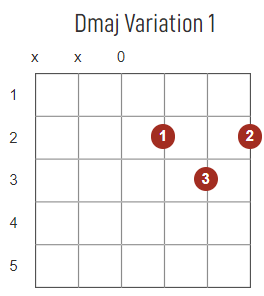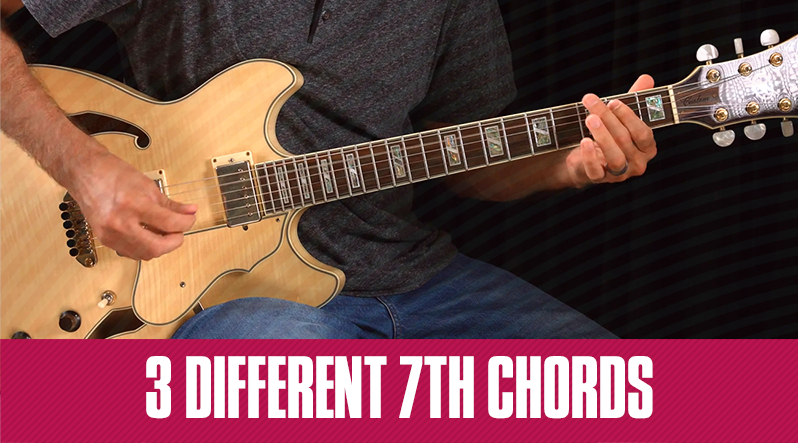Basic guitar chords are open chords like C major, D major and F major.
For anyone taking guitar lessons, these are the very first chords you learn because their fingering is simple and straightforward.
These chords are also the most commonly used chords in popular music.
Major Chords
Let's jump right in with the basic open major chords.
These are your easy, happy campfire chords.
Major chords are a beginner's best friend.
Try your hand at these and see how many you might already know.
You can always use a guitar chord chart if you get stuck or want to know more. Like this one.
C major

This is arguably the most common chord of all time.
This is the C major chord, or the C chord. It consists of the C, E and G notes from the C major scale.
Like, the F chord, your 2nd and 3rd fingers create a staircase-like shape.
It could be tough to learn at first because your 1st finger may mute the high E string so be sure to have proper finger positioning on this one.
F major

Just like the C major chord, the F major chord borrows a very similar shape.
Instead of leaving the G string open, you’ll have to hold the 2nd fret with your 2nd finger, while your 3rd finger is on the 3rd fret of the D string.
Moving between the C major and F major chord is one of the first chord switches you may learn since the 1st finger is in the same position for both chords.
It's also important to note that it's not essential to play F major as a barre chord.
A major

The A major chord is great because when you’re first learning how to play guitar, you may have to think about which fret to put each finger.
Thankfully, the entire A major chord is on the 2nd fret.
Some guitar players use fingers 1, 2, and 3 on 2nd fret of the D, G and B strings.
It’s also perfectly acceptable to barre all three notes with a single finger as well.
D major

Unlike the A major or the C major chords, the D major uses a different type of chord shape.
It’s easy to remember the D major chord if you think about it like a triangle.
Use your first two fingers to hold down the 2nd frets of the G and the high E string and then use your middle or 3rd finger to hold down the 3rd fret of the B string.
D major sounds bright and if you pick out the notes individually with a capo on the 7th fret, you can almost put together the opening bits of The Beatles classic, “Here Comes the Sun.”
G major

Get ready for the claw because the G chord requires your hands to make a sort of claw shape.
A lot of songs use this basic guitar chord since you don't need to mute any strings.
It can also be difficult to switch from this chord to other chords at first because of its interesting shape.
The tricky part of this chord is hitting that high E string.
Most players use their 3rd finger but if you’re performing some advanced tricks, you pay end up using your pinky there as well.
E major

The E major open chord is the just like the A minor chord shape except down a string.
PRO TIP: Once you learn how to play this chord, you’re on your way to learning barre chords.
E major also uses every string, which means the strings you’re not pressing down are strummed completely open.
Minor Chords
Minor chords have a darker quality.
If major chords are considered happy, minor chords are "sad."
If you take the 3rd scale degree of any major chord and move it down a half step, you've got yourself a minor chord.
Don't worry, there isn't a test at the end of this article.
Just as above, take a spin at these easy open minor chords.
Some of them might be super easy to you!
A minor

The A minor chord is just like the E major chord but moved up one string.
Another way to think about this chord is that it’s like an A major chord, but you’ll simply move the the note on the B string from the 2nd fret to the 1st fret.
However, remember to muste that low E string. While it is a note in the chord, it doesn't sound right when played on the low E string.
E minor

The E minor is exactly the same as the E major chord minus the note on the G string.
That’s it! Everything else is exactly the same, including the open strings.
If you have two fingers and a guitar, you can play an E minor.
D minor

The D minor chord is very similar to the D major chord in shape, but you’ll move the note you’re playing on the high E string from the 2nd fret to the 1st fret.
Be sure to not strum the 5th and 6th strings because they’re muted. If you play a D minor arpeggio, it sounds pretty cool, too!
B minor

This is the only chord on this list that isn’t played completely open.
Despite this, B minor is still a very common chord shape and may be your first crack at a barre chord.
The B minor is played at the 2nd fret and borrows a very similar shape as the F major chord but played a string higher.
See if you can play it completely barred from the 1st to the 5th string, but be sure to mute that low E string or else it will sound a little off.
These are some great basic chords to get started with.
Practice all of these, put them together in order, make up your own order (hey, a chord progression!) or just play one at a time until you've mastered it.
When you try to move from one chord to the next, really focus on nailing those finger positions before strumming the chord.
It might be slow going at first, but don't worry, it will speed up with time and practice.
Remember, you only need to know 3 chords to learn hundreds of easy guitar songs.
Grab your guitar and start playing today!

